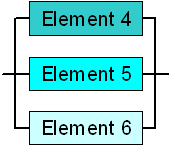Basic reliability cookbook
K-of-N Reliability

K-of-N reliability is
used when K of N (K≤N)
identical elements need to be functional for the combination to be
useful. Given a set of N
identical elements, the reliability of the combination is the sum of the
probabilities that N elements will survive, that N-1 elements will
survive, that N-2 elements will survive, and so on, down to K surviving
elements.
The probability that a
specific number J of elements will survive is the product of the serial
reliability of J active elements, the parallel unreliability of N-J
inactive elements and the combination of N elements taken J at a time.
Identical elements E1,
E2,
… EN
have reliability P. The
serial reliability of the J active elements is PJ.
The parallel unreliability of the N-J inactive elements is (1-P)(N-J).
The combination of N elements taken J at a time is N! / (J! *
(N-J)!). The probability
that J elements will survive is PS(J)
= PJ
* (1-P)(N-J)
* N! / (J! * (N-J)!).
The combined K-of-N
reliability of the N elements is PS(N)
+ PS(N-1)
+ PS(N-2)
+ … + PS(K).
For example, a 4-of-6 system has elements with reliability 0.8. The K-of-N reliability is PS(4) + PS(5) + PS(6) = 0.24576 + 0.393216 + 0.262144 = 0.90112.
In the special case where K=N, the N-of-N reliability is
the same as the serial reliability of N identical elements.
In the special case where K=1, the 1-of-N reliability is
the same as the parallel reliability of N identical elements.
Failure Rate | Serial Reliability | Parallel Reliability | K of N Reliability | Standby Reliability | Duty Cycle Reliability
